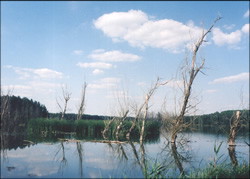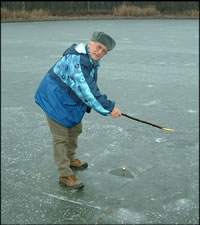 |
Wetland dynamics - trees drowned
by shifting waters |
In Hungary, the wetland area is strictly protected as a national park;
in Croatia it forms the Kopacki Rit Nature Park, and in Serbia the Gornje
Podunavlje Special Nature Reserve. Lying in the north-west part of Vojvodina
Province, Gornje Podunavlje is the largest riparian wetland along the Serbian
section of the Danube, its mosaic of plant and animal habitats formed by
the meandering history of this great river. Much of the natural floodplain,
up to 10km wide in places, has lost its original complex character through
drainage, forestry and agriculture activities and the the construction of
dykes; softwood species – willow and poplar – now dominate.
However, the flooded forest in the inundation area near Apatin has survived,
and throughout the area there are numerous dead riverbranches, oxbows, wet
meadows, marshy depressions and reedbeds. On the edge of the floodplain,
inside the Reserve, higher areas of loess exhibit dry halophylous meadows
and stands of xerophylous Quercus cerris.
Biological and cultural diversity
 |
Fishing through an ice-hole near
Apatin |
The habitats of Gornje Podunavlje are of outstanding biodiversity, as the
species numbers alone illustrate: 1032 plant taxa in the wider area, 55
species of fish, 11 of amphibians, 230 of birds (145 of these breeding here),
and 51 mammals, to mention only the most-researched groups. Flagship species,
good indicators of the quality of the habitats, include the white-tailed
eagle and black stork, which have their national strongholds in the area.
Among mammals, red deer and wild boar are characteristic. Plant species
include the endangered, internationally important, Eranthis hyemalis, Hottonia
palustris, Iris spuria, and Crataegus nigra. The rich ecology of the region
and the complex history of Vojvodina Province has given rise to a mosaic
of cultural expression, based around distinct ethnic identities. The cities
of Apatin and Sombor are of medieval origin, and the charming villages and
cottages of western Backa retain their traditional rural life style.
The biggest impact on the floodplain was made by the construction of dykes
along the river bank, especially the completion of a very large dyke in
the 1960s, which isolated from the river almost 5,000 hectares of formerly
flooded land near Backi Monostor. The biggest threat to the survival of
nature comes from intensive commercial forestry, which replaces diverse
autochthonous forest stands with sterile monocultures of fast-growing poplar
clones: this has a profoundly damaging effect on the overall biodiversity
of the floodplain ecosystem. However, the improvements to the water regime
being carried out by the Vojvodina Forestry company promise to benefit nature
through wetland revitalisation.
NGOs speak with one voice
The potential for sustainable use of the area’s natural resources
is still not widely recognised; as proved elsewhere, a judicious mix of
ecotourism, sustainable forestry and the marketing of local products could
generate local income without destroying the area’s natural heritage.
However, NGOs from the three countries involved in transboundary cooperation
do seem to be aware of this potential. Together, they are calling for the
establishment of a unified, international, protected area, with management
standards appropriate to its huge ecological value. In the scenario they
are proposing, the ecotourism potential of such an international region,
extremely attractive to tourists, would be developed as a primary economic
activity.
Slobodan Puzovi’c, assistant to the Environmental Protection Secretariat
of Vojvodina Province, recognises that it is crucial that local economic
needs be harmonized with the management of the Reserve. “Sustainable
tourism and the provision of tourist services could stimulate the local
economy,” he says. “We should also re-establish traditional
management practices in some areas, such as extensive animal husbandry”.
In terms of the international potential, Mr. Puzovic says that “transboundary
cooperation with Hungary and Croatia is a top priority in all environmental
strategies, at both provincial and national levels”.
More information:
http://www.biblioso.org.yu/ekologija/eko_en/ekologija.htm
INFORMATION
GORNJE PODUNAVLJE SPECIAL NATURE
RESERVE
Size: 19,648 ha
Protection regimes: 262 ha is in the strictly protected
core zone, with 4,844 ha of valuable wetlands and relict
forests in the buffer zone, and another 14,534 ha in the
transition zone.
International status: Important Bird Area since 1989.
IBA status confirmed in 2000, on 30,000 ha (including
land contiguous with the reserve). Potential national -
or part of an international - Ramsar Site; also part of
the Danube-Drava-Mura Biosphere Reserve proposed by
EURONATUR in 1997.